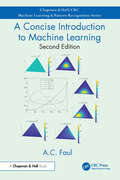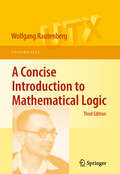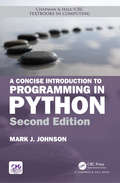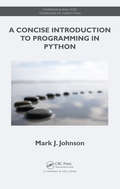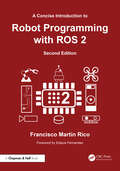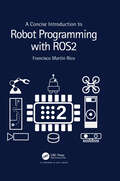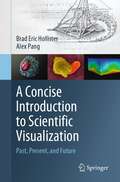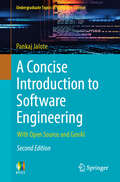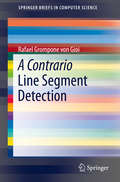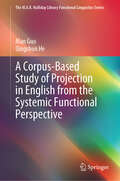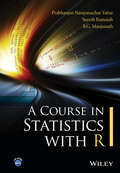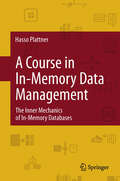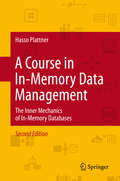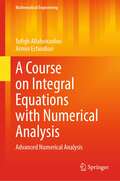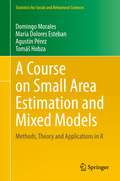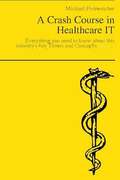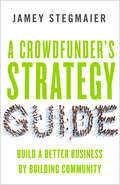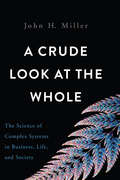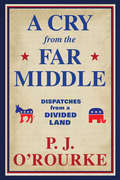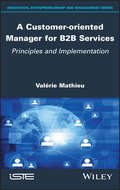- Table View
- List View
A Concise Introduction to Machine Learning (Chapman & Hall/CRC Machine Learning & Pattern Recognition)
by A.C. FaulA Concise Introduction to Machine Learning uses mathematics as the common language to explain a variety of machine learning concepts from basic principles and illustrates every concept using examples in both Python and MATLAB®, which are available on GitHub and can be run from there in Binder in a web browser. Each chapter concludes with exercises to explore the content.The emphasis of the book is on the question of Why—only if “why” an algorithm is successful is understood, can it be properly applied and the results trusted. Standard techniques are treated rigorously, including an introduction to the necessary probability theory. This book addresses the commonalities of methods, aims to give a thorough and in-depth treatment and develop intuition for the inner workings of algorithms, while remaining concise.This useful reference should be essential on the bookshelf of anyone employing machine learning techniques, since it is born out of strong experience in university teaching and research on algorithms, while remaining approachable and readable.
A Concise Introduction to Mathematical Logic (Universitext)
by Wolfgang RautenbergTraditional logic as a part of philosophy is one of the oldest scientific disciplines and can be traced back to the Stoics and to Aristotle. Mathematical logic, however, is a relatively young discipline and arose from the endeavors of Peano, Frege, and others to create a logistic foundation for mathematics. It steadily developed during the twentieth century into a broad discipline with several sub-areas and numerous applications in mathematics, informatics, linguistics and philosophy. This book treats the most important material in a concise and streamlined fashion. The third edition is a thorough and expanded revision of the former. Although the book is intended for use as a graduate text, the first three chapters can easily be read by undergraduates interested in mathematical logic. These initial chapters cover the material for an introductory course on mathematical logic, combined with applications of formalization techniques to set theory. Chapter 3 is partly of descriptive nature, providing a view towards algorithmic decision problems, automated theorem proving, non-standard models including non-standard analysis, and related topics. The remaining chapters contain basic material on logic programming for logicians and computer scientists, model theory, recursion theory, Gödel's Incompleteness Theorems, and applications of mathematical logic. Philosophical and foundational problems of mathematics are discussed throughout the text. Each section of the seven chapters ends with exercises some of which of importance for the text itself. There are hints to most of the exercises in a separate file Solution Hints to the Exercises which is not part of the book but is available from the author's website.
A Concise Introduction to Programming in Python (Chapman & Hall/CRC Textbooks in Computing #12)
by Mark J. JohnsonA Concise Introduction to Programming in Python, Second Edition provides a hands-on and accessible introduction to writing software in Python, with no prior programming experience required. The Second Edition was thoroughly reorganized and rewritten based on classroom experience to incorporate: A spiral approach, starting with turtle graphics, and then revisiting concepts in greater depth using numeric, textual, and image data Clear, concise explanations written for beginning students, emphasizing core principles A variety of accessible examples, focusing on key concepts Diagrams to help visualize new concepts New sections on recursion and exception handling, as well as an earlier introduction of lists, based on instructor feedback The text offers sections designed for approximately one class period each, and proceeds gradually from procedural to object-oriented design. Examples, exercises, and projects are included from diverse application domains, including finance, biology, image processing, and textual analysis. It also includes a brief "How-To" sections that introduce optional topics students may be interested in exploring. The text is written to be read, making it a good fit in flipped classrooms. Designed for either classroom use or self-study, all example programs and solutions to odd-numbered exercises (except for projects) are available at: http://www.central.edu/go/conciseintro/.
A Concise Introduction to Programming in Python (Chapman And Hall/crc Textbooks In Computing Ser.)
by Mark J. JohnsonSuitable for newcomers to computer science, A Concise Introduction to Programming in Python provides a succinct, yet complete, first course in computer science using the Python programming language. The book features:Short, modular chapters with brief and precise explanations, intended for one class periodEarly introduction of basic procedural cons
A Concise Introduction to Robot Programming with ROS 2
by Francisco Martín RicoA Concise Introduction to Robot Programming with ROS2 provides the reader with the concepts and tools necessary to bring a robot to life through programming. It will equip the reader with the skills necessary to undertake projects with ROS2, the new version of ROS. It is not necessary to have previous experience with ROS2 as it will describe its concepts, tools, and methodologies from the beginning. Uses the two programming languages officially supported in ROS 2 (C++, mainly, and Python) Approaches ROS 2 from three different but complementary dimensions: the Community, Computation Graph, and the Workspace Includes a complete simulated robot, development and testing strategies, Behavior Trees, and Nav2 description, setup, and use A GitHub repository with code to assist readers It will appeal to motivated engineering students, engineers, and professionals working with robot programming.
A Concise Introduction to Robot Programming with ROS2
by Francisco Martín RicoA Concise Introduction to Robot Programming with ROS2 provides the reader with the concepts and tools necessary to bring a robot to life through programming. It will equip the reader with the skills necessary to undertake projects with ROS2, the new version of ROS. It is not necessary to have previous experience with ROS2 as it will describe its concepts, tools, and methodologies from the beginning. Key Features Uses the two programming languages officially supported in ROS2 (C++, mainly, and Python) Approaches ROS2 from three different but complementary dimensions: the Community, Computation Graph, and the Workspace Includes a complete simulated robot, development and testing strategies, Behavior Trees, and Nav2 description, setup, and use A GitHub repository with code to assist readers It will appeal to motivated engineering students, engineers, and professionals working with robot programming.
A Concise Introduction to Scientific Visualization: Past, Present, and Future
by Brad Eric Hollister Alex PangScientific visualization has always been an integral part of discovery, starting first with simplified drawings of the pre-Enlightenment and progressing to present day. Mathematical formalism often supersedes visual methods, but their use is at the core of the mental process. As historical examples, a spatial description of flow led to electromagnetic theory, and without visualization of crystals, structural chemistry would not exist. With the advent of computer graphics technology, visualization has become a driving force in modern computing. A Concise Introduction to Scientific Visualization – Past, Present, and Future serves as a primer to visualization without assuming prior knowledge. It discusses both the history of visualization in scientific endeavour, and how scientific visualization is currently shaping the progress of science as a multi-disciplinary domain.
A Concise Introduction to Software Engineering: With Open Source and GenAI (Undergraduate Topics in Computer Science)
by Pankaj JaloteSoftware engineering has changed: A software project today is likely to use large language models (LLMs) for some tasks and will employ some open-source software. It is therefore important to integrate open source and use of LLMs in teaching software engineering – a key goal of this textbook. This reader-friendly textbook/reference introduces a carefully curated set of concepts and practices essential for key tasks in software projects. It begins with a chapter covering industry-standard software, open-source tools, and the basics of prompt engineering for LLMs. The second chapter delves into project management, including development process models, planning, and team-working. Subsequent chapters focus on requirements analysis and specification, architecture design, software design, coding, testing, and application deployment. Each chapter presents concepts, practical methods, examples, the application of LLMs, and the role of open-source software. A companion website provides some comprehensive case studies, as well as teaching material including presentation slides. This textbook is ideal for an introductory course on software engineering where the objective is to develop knowledge and skills to execute a project—specifically in a team employing contemporary software engineering practices and using open source and LLMs. It is also suitable for professionals who want to be introduced to the systematic approach of software engineering and/or use of open source and LLMs. The author is a distinguished professor at IIIT-Delhi and a well-known academic in software engineering. He has served as vice president in Infosys Technologies Limited and as a visiting researcher at Microsoft Corporation. Reviews of the first edition: "This book's title provides an excellent description of its content. ... This compact volume is organized into eight well-focused chapters containing numerous examples and well-designed self-test exercises. Includes an excellent collection of references and a very useful index. Summing Up: Highly recommended. Upper-division undergraduate through professional readers; two-year technical program students." (J. Beidler, Choice, Vol. 46 (6)) "Jalote's intention in this book is to present just enough material to teach beginning software engineers what they need to know to do a development project that carries a smallproduct from conception through delivery. The result is a short book ... making this sort of book very attractive as a text for introductory software engineering. ... topics are well chosen and their discussion is good." (Christopher Fox, ACM Computing Reviews)
A Contrario Line Segment Detection (SpringerBriefs in Computer Science)
by Rafael Grompone von GioiThe reliable detection of low-level image structures is an old and still challenging problem in computer vision. This book leads a detailed tour through the LSD algorithm, a line segment detector designed to be fully automatic. Based on the a contrario framework, the algorithm works efficiently without the need of any parameter tuning. The design criteria are thoroughly explained and the algorithm's good and bad results are illustrated on real and synthetic images. The issues involved, as well as the strategies used, are common to many geometrical structure detection problems and some possible extensions are discussed.
A Corpus-Based Study of Projection in English from the Systemic Functional Perspective (The M.A.K. Halliday Library Functional Linguistics Series)
by Qingshun He Man GuoThis book presents a comprehensive study on the phenomenon of projection in English language, drawing upon Halliday’s systemic functional linguistics (SFL) model. It aims to clarify the grammatical status of projecting and projected clauses and explore their synchronic distribution features as well as diachronic evolution patterns. This book provides insights into the understanding of the grammatical status of projection-related clauses. Furthermore, the uncovering of historical evolution trends contributes to the literature on grammatical metaphor in SFL. From a practical standpoint, the empirical investigations into the relationship between projection and text technicality provide important implications for English teaching pedagogy and discourse analysis.
A Course In Statistics With R
by Prabhanjan N. Tattar Suresh Ramaiah B. G. ManjunathIntegrates the theory and applications of statistics using R "A Course in Statistics with R" has been written to bridge the gap between theory and applications and explain how mathematical expressions are converted into R programs. The book has been primarily designed as a useful companion for a Masters student during each semester of the course, but will also help applied statisticians in revisiting the underpinnings of the subject. With this dual goal in mind, the book begins with R basics and quickly covers visualization and exploratory analysis. Probability and statistical inference, inclusive of classical, nonparametric, and Bayesian schools, is developed with definitions, motivations, mathematical expression and R programs in a way which will help the reader to understand the mathematical development as well as R implementation. Linear regression models, experimental designs, multivariate analysis, and categorical data analysis are treated in a way which makes effective use of visualization techniques and the related statistical techniques underlying them through practical applications, and hence helps the reader to achieve a clear understanding of the associated statistical models. "Key features" Integrates R basics with statistical concepts Provides graphical presentations inclusive of mathematical expressions Aids understanding of limit theorems of probability with and without the simulation approach Presents detailed algorithmic development of statistical models from scratch Includes practical applications with over 50 data sets
A Course in Algebraic Error-Correcting Codes (Compact Textbooks in Mathematics)
by Simeon BallThis textbook provides a rigorous mathematical perspective on error-correcting codes, starting with the basics and progressing through to the state-of-the-art. Algebraic, combinatorial, and geometric approaches to coding theory are adopted with the aim of highlighting how coding can have an important real-world impact. Because it carefully balances both theory and applications, this book will be an indispensable resource for readers seeking a timely treatment of error-correcting codes. Early chapters cover fundamental concepts, introducing Shannon’s theorem, asymptotically good codes and linear codes. The book then goes on to cover other types of codes including chapters on cyclic codes, maximum distance separable codes, LDPC codes, p-adic codes, amongst others. Those undertaking independent study will appreciate the helpful exercises with selected solutions. A Course in Algebraic Error-Correcting Codes suits an interdisciplinary audience at the Masters level, including students of mathematics, engineering, physics, and computer science. Advanced undergraduates will find this a useful resource as well. An understanding of linear algebra is assumed.
A Course in In-Memory Data Management: The Inner Mechanics of In-Memory Databases
by Hasso PlattnerRecent achievements in hardware and software development, such as multi-core CPUs and DRAM capacities of multiple terabytes per server, enabled the introduction of a revolutionary technology: in-memory data management. This technology supports the flexible and extremely fast analysis of massive amounts of enterprise data. Professor Hasso Plattner and his research group at the Hasso Plattner Institute in Potsdam, Germany, have been investigating and teaching the corresponding concepts and their adoption in the software industry for years. This book is based on the first online course on the openHPI e-learning platform, which was launched in autumn 2012 with more than 13,000 learners. The book is designed for students of computer science, software engineering, and IT related subjects. However, it addresses business experts, decision makers, software developers, technology experts, and IT analysts alike. Plattner and his group focus on exploring the inner mechanics of a column-oriented dictionary-encoded in-memory database. Covered topics include - amongst others - physical data storage and access, basic database operators, compression mechanisms, and parallel join algorithms. Beyond that, implications for future enterprise applications and their development are discussed. Readers are lead to understand the radical differences and advantages of the new technology over traditional row-oriented disk-based databases.
A Course in In-Memory Data Management: The Inner Mechanics of In-Memory Databases
by Hasso PlattnerRecent achievements in hardware and software development, such as multi-core CPUs and DRAM capacities of multiple terabytes per server, enabled the introduction of a revolutionary technology: in-memory data management. This technology supports the flexible and extremely fast analysis of massive amounts of enterprise data. Professor Hasso Plattner and his research group at the Hasso Plattner Institute in Potsdam, Germany, have been investigating and teaching the corresponding concepts and their adoption in the software industry for years. This book is based on an online course that was first launched in autumn 2012 with more than 13,000 enrolled students and marked the successful starting point of the openHPI e-learning platform. The course is mainly designed for students of computer science, software engineering, and IT related subjects, but addresses business experts, software developers, technology experts, and IT analysts alike. Plattner and his group focus on exploring the inner mechanics of a column-oriented dictionary-encoded in-memory database. Covered topics include - amongst others - physical data storage and access, basic database operators, compression mechanisms, and parallel join algorithms. Beyond that, implications for future enterprise applications and their development are discussed. Step by step, readers will understand the radical differences and advantages of the new technology over traditional row-oriented, disk-based databases. In this completely revised 2nd edition, we incorporate the feedback of thousands of course participants on openHPI and take into account latest advancements in hard- and software. Improved figures, explanations, and examples further ease the understanding of the concepts presented. We introduce advanced data management techniques such as transparent aggregate caches and provide new showcases that demonstrate the potential of in-memory databases for two diverse industries: retail and life sciences.
A Course on Integral Equations with Numerical Analysis: Advanced Numerical Analysis (Mathematical Engineering)
by Tofigh Allahviranloo Armin EsfandiariThis book suggests that the numerical analysis subjects’ matter are the important tools of the book topic, because numerical errors and methods have important roles in solving integral equations. Therefore, all needed topics including a brief description of interpolation are explained in the book. The integral equations have many applications in the engineering, medical, and economic sciences, so the present book contains new and useful materials about interval computations including interval interpolations that are going to be used in interval integral equations. The concepts of integral equations are going to be discussed in two directions, analytical concepts, and numerical solutions which both are necessary for these kinds of dynamic systems. The differences between this book with the others are a full discussion of error topics and also using interval interpolations concepts to obtain interval integral equations. All researchers and students in the field of mathematical, computer, and also engineering sciences can benefit the subjects of the book.
A Course on Small Area Estimation and Mixed Models: Methods, Theory and Applications in R (Statistics for Social and Behavioral Sciences)
by Domingo Morales María Dolores Esteban Agustín Pérez Tomáš HobzaThis advanced textbook explores small area estimation techniques, covers the underlying mathematical and statistical theory and offers hands-on support with their implementation. It presents the theory in a rigorous way and compares and contrasts various statistical methodologies, helping readers understand how to develop new methodologies for small area estimation. It also includes numerous sample applications of small area estimation techniques. The underlying R code is provided in the text and applied to four datasets that mimic data from labor markets and living conditions surveys, where the socioeconomic indicators include the small area estimation of total unemployment, unemployment rates, average annual household incomes and poverty indicators. Given its scope, the book will be useful for master and PhD students, and for official and other applied statisticians.
A Crash Course In Healthcare IT: Everything You Need to Know About this Industry
by Michael FishweicherIf you’re started already. You probably have noticed that here is a lot of industry related information that any staff member may come across on any given day. If you’re like me and want to be sure that you’re able to carry an intelligent conversation with a co-worker, client, or potential cacnt.
A Creeper Camps Out: The Creeper Diaries, An Unofficial Minecrafters Novel, Book Eleven (The Creeper Diaries #11)
by Greyson MannGerald isn’t exactly thrilled when his parents send him to summer camp. Building shelters? Not really his thing. Gathering mushrooms? Thanks, but no thanks. Tracking wolves? Um . . . NO. <P><P>Gerald especially dreads Survival Night, when he and his friend Sam have to sleep outside in the woods. <P><P>When Gerald stumbles onto an abandoned woodland mansion, he thinks it’s the perfect place to spend Survival Night! But a rival camp of villagers has already claimed the mansion. <P><P>Can Gerald find the courage to stand up to them? He’s going to need ALL his survival skills to defend his discovery—and his good buddy Sam.
A Crowdfunder's Strategy Guide: Build a Better Business by Building Community
by Jamey StegmaierMore Than MoneyJamey Stegmaier knows crowdfunding. He's a veteran of seven successful Kickstarter campaigns (and counting) that have raised over $3.2 million, and he's the proprietor of the widely read Kickstarter Lessons blog. In this book he offers a comprehensive guide to crowdfunding, demonstrating that it can be a powerful way for entrepreneurs to grow their businesses by building community and putting their customers first.This book includes over forty stories of inspiring successes and sobering disasters. Stegmaier uses these examples to demonstrate how to (and how not to) prepare for a campaign, grow a fan base, structure a pitch, find new backers, and execute many other crucially important "nuts and bolts" elements of a successful crowdfunding project.But Stegmaier emphasizes that the benefits of crowdfunding are much more about the "crowd" than the "funding." He shows that if you treat your backers as people, not pocketbooks—communicate regularly and transparently with them, ask their opinions, attend to their needs—they'll become advocates as well as funders, exponentially increasing your project's chances of succeeding.
A Crude Look at the Whole: The Science of Complex Systems in Business, Life, and Society
by John H. MillerImagine trying to understand a stained glass window by breaking it into pieces and examining it one shard at a time. While you could probably learn a lot about each piece, you would have no idea about what the entire picture looks like. This is reductionism--the idea that to understand the world we only need to study its pieces--and it is how most social scientists approach their work. In A Crude Look at the Whole, social scientist and economist John H. Miller shows why we need to start looking at whole pictures. For one thing, whether we are talking about stock markets, computer networks, or biological organisms, individual parts only make sense when we remember that they are part of larger wholes. And perhaps more importantly, those wholes can take on behaviors that are strikingly different from that of their pieces. Miller, a leading expert in the computational study of complex adaptive systems, reveals astounding global patterns linking the organization of otherwise radically different structures: It might seem crude, but a beehive’s temperature control system can help predict market fluctuations and a mammal’s heartbeat can help us understand the "heartbeat” of a city and adapt urban planning accordingly. From enduring racial segregation to sudden stock market disasters, once we start drawing links between complex systems, we can start solving what otherwise might be totally intractable problems. Thanks to this revolutionary perspective, we can finally transcend the limits of reductionism and discover crucial new ideas. Scientifically founded and beautifully written, A Crude Look at the Whole is a powerful exploration of the challenges that we face as a society. As it reveals, taking the crude look might be the only way to truly see.
A Cry from the Far Middle: Dispatches from a Divided Land
by P.J. O'RourkeIn a time of chaos, the #1 New York Times-bestselling political humorist asks his fellow Americans to take it down a notch. Is there an upside to being woke (and unable to get back to sleep)? If we license dentists, why don&’t we license politicians? Is your juicer sending fake news to your FitBit about what&’s in your refrigerator? The legendary P.J. O&’Rourke addresses these questions and more in this hilarious new collection of essays about our nation&’s propensity for anger and perplexity, which includes such gems as &“An Inaugural Address I&’d Like to Hear&” (Ask not what your country can do for you, ask how I can get the hell out of here) and &“Sympathy vs. Empathy,&” which contemplates whether it&’s better to hold people&’s hands or bust into their heads. Also included is a handy quiz to find out where you stand on the Coastals-vs.-Heartlanders spectrum. From the author of Parliament of Whores, None of My Business, and other modern classics, this is a smart look at the current state of these United States, and a plea to everyone to take a deep breath, relax, and enjoy a few good laughs. &“To say that P. J. O&’Rourke is funny is like saying the Rocky Mountains are scenic—accurate but insufficient.&” —Chicago Tribune &“The funniest writer in America.&”—The Wall Street Journal
A Cryptography Primer
by Philip N. KleinCryptography has been employed in war and diplomacy from the time of Julius Caesar. In our Internet age, cryptography's most widespread application may be for commerce, from protecting the security of electronic transfers to guarding communication from industrial espionage. This accessible introduction for undergraduates explains the cryptographic protocols for achieving privacy of communication and the use of digital signatures for certifying the validity, integrity, and origin of a message, document, or program. Rather than offering a how-to on configuring web browsers and e-mail programs, the author provides a guide to the principles and elementary mathematics underlying modern cryptography, giving readers a look under the hood for security techniques and the reasons they are thought to be secure.
A Cursed Place: A page-turning thriller of the dark world of cyber surveillance (William Carver Novels)
by Peter HaningtonReporter William Carver comes up against Big Tech's manipulation and suppression of truth from the mines of Chile to the turbulent streets of Hong Kong.Knowledge is power. And they know everything.The tech company Public Square believes in 'doing well by doing good'. It's built a multi-billion dollar business on this philosophy and by getting to know what people want. They know a lot. But who else can access all that information and what are they planning to do with it?Reporter William Carver is an analogue man in a digital world. He isn't the most tech-savvy reporter, he's definitely old school, but he needs to learn fast - the people he cares most about are in harm's way.From the Chilean mines where they dig for raw materials that enable the tech revolution, to the streets of Hong Kong where anti-government protesters are fighting against the Chinese State, to the shiny research laboratories of Silicon Valley where personal data is being mined everyday - A Cursed Place is a gripping thriller set against the global forces that shape our times.(P) 2021 Hodder & Stoughton
A Cursed Place: A page-turning thriller of the dark world of cyber surveillance (William Carver Novels)
by Peter Hanington*ONE OF 40 BOOKS FOR SUMMER* 'gripping'- iNews'A panoramic thriller ...chockful of vivid characters.' - THE SUNDAY TIMES'An intriguing, timely and unsettling new thriller' - SAM BOURNE'Exhilarating and beautiful' - AMOL RAJAN'Catapults you from first word to last... pacy, sinister and timely read.' - ALAN JUDD'Another page-turner from a writer who can take you into gripping worlds, real and virtual.' MISHAL HUSAIN 'A terrific thriller - vivid, quick-witted and dynamic, crackling with energy, dread and rage as it crosses continents and digs down into the human heart.' - NICCI GERRARD 'The dark world of private cyber-surveillance crackles off the page - full of jeopardy and suspense.' - ALLAN LITTLE 'A vividly written thriller of ruthless tech entrepreneurs exploiting their surveillance powers and morally compromised journalists feeling their way in the dark towards the truth.' - RORY CELLAN-JONES'Carver is a marvellous creation.' - MIKE RIPLEY, SHOTS MAGKNOWLEDGE IS POWER. AND THEY KNOW EVERYTHING.The tech company Public Square believes in 'doing well by doing good'. It's built a multi-billion dollar business on this philosophy and by getting to know what people want. They know a lot. But who else can access all that information and what are they planning to do with it?Reporter William Carver is an analogue man in a digital world. He isn't the most tech-savvy reporter, he's definitely old school, but he needs to learn fast - the people he cares most about are in harm's way.From the Chilean mines where they dig for raw materials that enable the tech revolution, to the streets of Hong Kong where anti-government protesters are fighting against the Chinese State, to the shiny research laboratories of Silicon Valley where personal data is being mined everyday - A Cursed Place is a gripping thriller set against the global forces that shape our times.'A true page turner - highly recommended'. TORTOISE
A Customer-oriented Manager for B2B Services: Principles and Implementation
by Valerie MathieuThe notion of customer orientation is becoming a necessity rather than a choice for many companies. It is a lasting response to competitive pressure and supports the company in a renewed definition of its mission, beyond direct economic gain. Within B2B services, the manager, through proximity to their team, their market and their client, is the essential actor in the deployment of this orientation.A Customer-oriented Manager for B2B Services provides managers with the knowledge and tools necessary to implement customer orientation themselves, with the involvement of their extended team. To this end, this book presents a four-step approach: understand the fundamentals of customer orientation in B2B services, know the customer, make the most of the offer and deliver the service.
